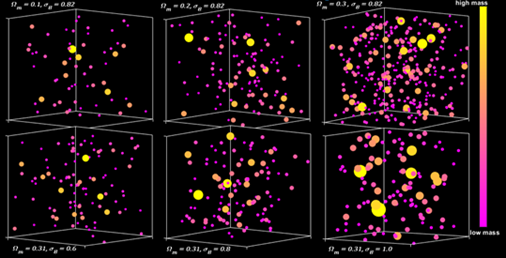One of the most intriguing and significant questions in cosmology is, “How much matter exists in the universe?” An international group, including researchers at Chiba University, has now succeeded in quantifying the entire amount of matter for the second time.

The dependence of the number of galaxy clusters on the total amount of matter. Like Goldilocks, the team compared the number of galaxy clusters measured with predictions from numerical simulations to determine which answer was “just right.” Image Credit: Mohamed Abdullah (The National Research Institute of Astronomy and Geophysics, Egypt/Chiba University, Japan)
Reporting in The Astrophysical Journal, the research group identified that regular matter makes up 31% of the total amount of matter and energy present in the universe, with the remainder comprised of dark matter.
Cosmologists believe that only about 20% of the total matter is made of regular or ‘baryonic’ matter, which includes stars, galaxies, atoms, and life.
D.r Mohamed Abdullah, Study First Author and Researcher, National Research Institute of Astronomy and Geophysics-Egypt, Chiba University
Abdullah added, “About 80% is made of dark matter, whose mysterious nature is not yet known but may consist of some as-yet-undiscovered subatomic particles.”
“The team used a well-proven technique to determine the total amount of matter in the universe, which is to compare the observed number and mass of galaxy clusters per unit volume with predictions from numerical simulations,” stated co-author Gillian Wilson, Abdullah’s former graduate advisor and Professor of Physics and Vice Chancellor for research, innovation, and economic development at UC Merced, “The number of clusters observed at the present time, the so-called ‘cluster abundance,’ is very sensitive to cosmological conditions and, in particular, the total amount of matter.”
A higher percentage of the total matter in the universe would result in more clusters being formed. But it is difficult to measure the mass of any galaxy cluster accurately as most of the matter is dark, and we cannot see it directly with telescopes.
Anatoly Klypin, University of Virginia
To address this challenge, the research group was forced to utilize an indirect tracer of cluster mass. Scientists believe that highly massive clusters consist of more galaxies compared to less massive clusters (mass richness relation: MRR).
As galaxies consist of luminous stars, several galaxies present in each cluster could be used as a way of indirectly identifying its total mass. By quantifying numerous galaxies in every cluster in their sample from the Sloan Digital Sky Survey, the team was capable of evaluating the entire mass of each of the clusters.
Furthermore, they were able to make a comparison of the observed number and mass of galaxy clusters per unit volume against predictions from numerical simulations.
The best-fit match between simulations and observations was with a universe comprising 31% of the total matter, a value that was in outstanding agreement with that obtained with the help of cosmic microwave background (CMB) observations from the Planck satellite. Remarkably, CMB is an entirely independent method.
We have succeeded in making the first measurement of matter density using the MRR, which is in excellent agreement with that obtained by the Planck team using the CMB method.
Tomoaki Ishiyama, Chiba University
Ishiyama added, “This work further demonstrates that cluster abundance is a competitive technique for constraining cosmological parameters and complementary to non-cluster techniques such as CMB anisotropies, baryon acoustic oscillations, Type Ia supernovae, or gravitational lensing.”
The research group credits their achievement as being the first to successfully use spectroscopy, the method that isolates radiation into a spectrum of individual bands or colors, to accurately identify the distance to every cluster and the true member galaxies that are gravitationally bound to the cluster instead of background or foreground interlopers along with the line of sight.
Early studies that tried to utilize the MRR technique depended on much cruder and less precise imaging methods, like utilizing pictures of the sky taken at some wavelengths to identify the distance to each cluster and the close galaxies that were true members.
The study not only highlights the effectiveness of the MRR technique in discerning cosmological parameters but also provides insights into its applicability to newly available datasets.
These datasets are sourced from extensive, broad, and deep-field imaging, as well as spectroscopic galaxy surveys, including those conducted using instruments like the Subaru Telescope, Dark Energy Survey, Dark Energy Spectroscopic Instrument, Euclid Telescope, eROSITA Telescope, and the James Webb Space Telescope.
Journal Reference
Abdullah, M. H., et al. (2023) Constraining Cosmological Parameters Using the Cluster Mass–Richness Relation. The Astrophysical Journal. doi.org/10.3847/1538-4357/ace773